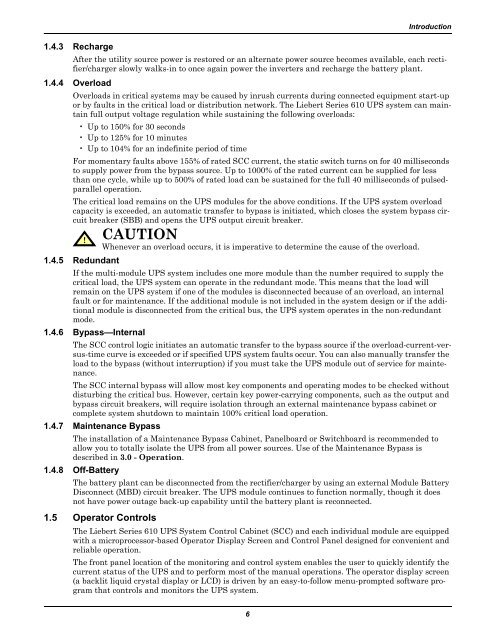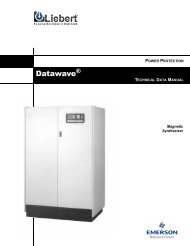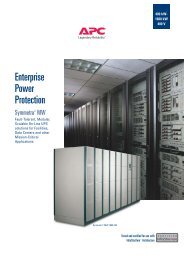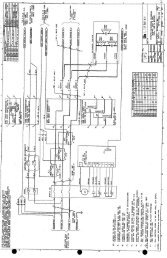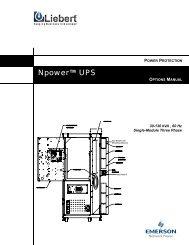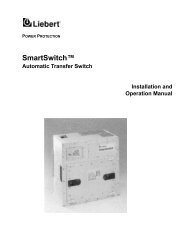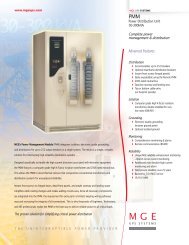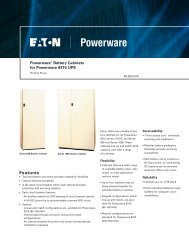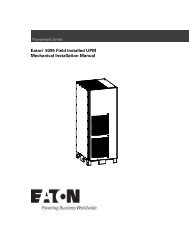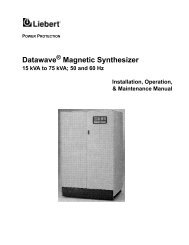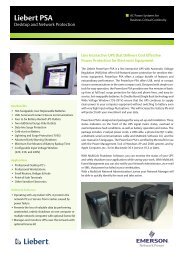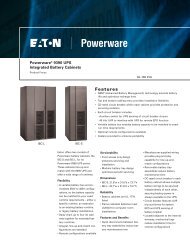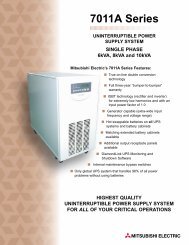Liebert® Series 610™ UPS - Jonweb.net
Liebert® Series 610™ UPS - Jonweb.net
Liebert® Series 610™ UPS - Jonweb.net
You also want an ePaper? Increase the reach of your titles
YUMPU automatically turns print PDFs into web optimized ePapers that Google loves.
1.4.3 Recharge<br />
Introduction<br />
After the utility source power is restored or an alternate power source becomes available, each rectifier/charger<br />
slowly walks-in to once again power the inverters and recharge the battery plant.<br />
1.4.4 Overload<br />
Overloads in critical systems may be caused by inrush currents during connected equipment start-up<br />
or by faults in the critical load or distribution <strong>net</strong>work. The Liebert <strong>Series</strong> 610 <strong>UPS</strong> system can maintain<br />
full output voltage regulation while sustaining the following overloads:<br />
• Up to 150% for 30 seconds<br />
• Up to 125% for 10 minutes<br />
• Up to 104% for an indefinite period of time<br />
For momentary faults above 155% of rated SCC current, the static switch turns on for 40 milliseconds<br />
to supply power from the bypass source. Up to 1000% of the rated current can be supplied for less<br />
than one cycle, while up to 500% of rated load can be sustained for the full 40 milliseconds of pulsedparallel<br />
operation.<br />
The critical load remains on the <strong>UPS</strong> modules for the above conditions. If the <strong>UPS</strong> system overload<br />
capacity is exceeded, an automatic transfer to bypass is initiated, which closes the system bypass circuit<br />
breaker (SBB) and opens the <strong>UPS</strong> output circuit breaker.<br />
!<br />
CAUTION<br />
Whenever an overload occurs, it is imperative to determine the cause of the overload.<br />
1.4.5 Redundant<br />
If the multi-module <strong>UPS</strong> system includes one more module than the number required to supply the<br />
critical load, the <strong>UPS</strong> system can operate in the redundant mode. This means that the load will<br />
remain on the <strong>UPS</strong> system if one of the modules is disconnected because of an overload, an internal<br />
fault or for maintenance. If the additional module is not included in the system design or if the additional<br />
module is disconnected from the critical bus, the <strong>UPS</strong> system operates in the non-redundant<br />
mode.<br />
1.4.6 Bypass—Internal<br />
The SCC control logic initiates an automatic transfer to the bypass source if the overload-current-versus-time<br />
curve is exceeded or if specified <strong>UPS</strong> system faults occur. You can also manually transfer the<br />
load to the bypass (without interruption) if you must take the <strong>UPS</strong> module out of service for maintenance.<br />
The SCC internal bypass will allow most key components and operating modes to be checked without<br />
disturbing the critical bus. However, certain key power-carrying components, such as the output and<br />
bypass circuit breakers, will require isolation through an external maintenance bypass cabi<strong>net</strong> or<br />
complete system shutdown to maintain 100% critical load operation.<br />
1.4.7 Maintenance Bypass<br />
The installation of a Maintenance Bypass Cabi<strong>net</strong>, Panelboard or Switchboard is recommended to<br />
allow you to totally isolate the <strong>UPS</strong> from all power sources. Use of the Maintenance Bypass is<br />
described in 3.0 - Operation.<br />
1.4.8 Off-Battery<br />
The battery plant can be disconnected from the rectifier/charger by using an external Module Battery<br />
Disconnect (MBD) circuit breaker. The <strong>UPS</strong> module continues to function normally, though it does<br />
not have power outage back-up capability until the battery plant is reconnected.<br />
1.5 Operator Controls<br />
The Liebert <strong>Series</strong> 610 <strong>UPS</strong> System Control Cabi<strong>net</strong> (SCC) and each individual module are equipped<br />
with a microprocessor-based Operator Display Screen and Control Panel designed for convenient and<br />
reliable operation.<br />
The front panel location of the monitoring and control system enables the user to quickly identify the<br />
current status of the <strong>UPS</strong> and to perform most of the manual operations. The operator display screen<br />
(a backlit liquid crystal display or LCD) is driven by an easy-to-follow menu-prompted software program<br />
that controls and monitors the <strong>UPS</strong> system.<br />
6


